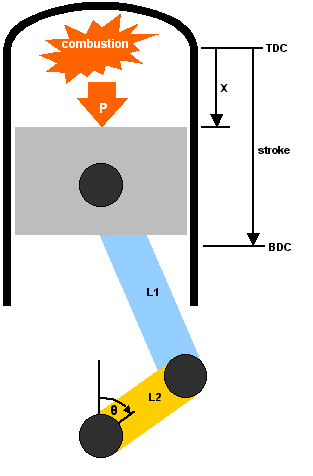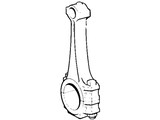Longer rods provide for a longer dwell at piston TDC, keeping the combustion chamber small for a longer period as the expanding gases push against the piston. This extracts more power from a given air/fuel mixture thus increasing combustion efficiency. And so much like with good quench, you've once again raised the amount of compression that you can utilize for a given combination (and octane) before detonation becomes a concern. Also, much as does a stroker set-up, longer rods benefit the power band (read "torque curve") with the largest advantages in the low and mid-range RPMs. Even in a stock bore and stroke combination, longer rods can give you some of the effect of a stroked engine. And in fact on a shorter stroke, an even longer rod can be used within the given limits of practicality, this meaning pin location on the piston.
Rod ratios vary from about 1.6 up to 2.0 with a few unusual engines outside these limits. A ratio of 1.8 is generally found to be a good compromise between low and high rpm power and other factors like piston thrust forces. However a shorter ratio leads to a stronger rod, more compact block and reduced weight.
Essentially a longer rod moves towards and away from TDC slower than a short rod and towards and away from BDC faster. A theoretically infinitely long rod would have a symmetrical motion curve with equal accelerations at TDC and BDC and peak piston speed at 90 degrees ATDC. In real engines the rods accelerate away from TDC about 70% to 90% faster than they do from BDC. This also means that peak piston speed occurs much earlier than 90 degrees ATDC - usually between 74 and 77 degrees ATDC i.e. much earlier than the intake valve reaches full lift. If we analyse the effects of all this on optimal valve timing events and other factors we find the following consequences of making the rod longer.
1) Intake valve needs to open earlier
2) Intake valve needs to close earlier
3) Exhaust valve needs to open later
4) Exhaust valve needs to close later
5) Intake port volume needs to decrease
6) Exhaust port volume needs to decrease
7) Compression ratio needs to drop
1 to 4 can all be achieved in one hit just by closing up the cam lobe centreline angle.
The effects are all relatively small. We're only talking the odd degree or two in valve events, a few percent at most in port volumes and CR for normal achievable changes in rod ratio in a given engine. Even going from a low ratio such as 1.6 to a very high one like 2.0 would only affect valve events by about 3 degrees.
Finally although a longer rod should benefit high rpm power slightly it should also theoretically hurt low rpm power slightly at the same time. A balance needs to be struck considering the use of the engine.
If engine breathing is restricted, as it seems to be in your case, then a longer rod will hurt low rpm power without necessarily being able to show its normal benefits at higher rpm.
http://www.gofastnews.com/showthread.php/1744-Cam-Timing-for-Longer-Connecting-Rods?p=8647
 AND if that is not enough information for you; try this:
AND if that is not enough information for you; try this:
The sketch on the left shows a piston moving down a cylinder bore as a consequence of combustion pressure. This pressure is converted to a force on the piston. (It is interesting to note that for a given combustion pressure, a bigger bore will give rise to a larger force on the piston)








